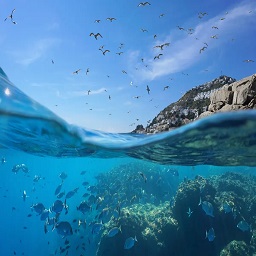متن انگلیسی در مورد اقیانوس ocean ، لکچر انگلیسی در مورد اقیانوس و دریا ocean

متن انگلیسی ساده در مورد اقیانوس
در پایین متن انگلیسی ساده، متن انگلیسی پیشرفته تری در مورد اقیانوس وجود دارد.
The ocean
The ocean is a vast body of saltwater that covers more than 70% of the Earth’s surface. It plays a crucial role in regulating the planet’s climate, providing habitat for countless species, and supporting various human activities.
The ocean is divided into five main basins:
the Pacific, Atlantic, Indian, Southern, and Arctic. Each basin has its own unique characteristics, including temperature, salinity, and marine life. The Pacific Ocean is the largest and deepest, while the Arctic Ocean is the smallest and shallowest.

diverse range of ecosystems
The ocean is home to a diverse range of ecosystems, including coral reefs, kelp forests, and deep-sea trenches. These ecosystems support an incredible array of marine life, from tiny plankton to giant whales. It is estimated that over one million species live in the ocean, with many more yet to be discovered.
plays a vital role in the Earth’s climate system
In addition to its ecological importance, the ocean also plays a vital role in the Earth’s climate system. It absorbs and stores heat from the sun, helping to regulate global temperatures. It also absorbs carbon dioxide, a greenhouse gas that contributes to climate change. However, increased levels of carbon dioxide have led to ocean acidification, which poses a threat to marine life and coral reefs.
valuable resource
The ocean is also a valuable resource for human beings. It provides a source of food, with over three billion people relying on fish as their primary source of protein. It also supports industries such as tourism, shipping, and oil and gas extraction. However, these activities can have negative impacts on the ocean, including pollution, overfishing, and habitat destruction.
To protect the ocean and ensure its sustainability
To protect the ocean and ensure its sustainability, it is important to implement conservation measures. This includes establishing marine protected areas, reducing plastic pollution, and promoting sustainable fishing practices. It is also crucial to raise awareness about the importance of the ocean and the need to protect it for future generations.
In conclusion
In conclusion, the ocean is a vital part of our planet. It provides habitat for numerous species, regulates the climate, and supports various human activities. However, it faces numerous challenges, including pollution, overfishing, and climate change. It is essential that we take action to protect the ocean and ensure its long-term health and sustainability.
اقیانوس
اقیانوس مجموعه وسیعی از آب شور است که بیش از 70 درصد از سطح زمین را پوشانده است. نقش مهمی در تنظیم آب و هوای سیاره، فراهم کردن زیستگاه برای گونه های بی شماری و حمایت از فعالیت های مختلف انسانی ایفا می کند.
اقیانوس به پنج حوضه اصلی تقسیم می شود:
اقیانوس آرام، اقیانوس اطلس، هند، جنوبی و قطب شمال. هر حوضه دارای ویژگی های منحصر به فرد خود از جمله دما، شوری و حیات دریایی است. اقیانوس آرام بزرگترین و عمیق ترین است، در حالی که اقیانوس منجمد شمالی کوچکترین و کم عمق ترین است. متن انگلیسی در مورد اقیانوس ocean
خانه طیف متنوعی از اکوسیستمها
اقیانوس خانه طیف متنوعی از اکوسیستمها، از جمله صخرههای مرجانی، جنگلهای کلپ و ترانشههای اعماق دریا است. این اکوسیستم ها از مجموعه ای باورنکردنی از حیات دریایی، از پلانکتون های کوچک گرفته تا نهنگ های غول پیکر پشتیبانی می کنند. تخمین زده میشود که بیش از یک میلیون گونه در اقیانوس زندگی میکنند و بسیاری از گونههای دیگر هنوز کشف نشدهاند.
نقش حیاتی در سیستم آب و هوای زمین
اقیانوس علاوه بر اهمیت اکولوژیکی، نقش حیاتی در سیستم آب و هوای زمین نیز دارد. گرمای خورشید را جذب و ذخیره می کند و به تنظیم دمای جهانی کمک می کند. همچنین دی اکسید کربن را جذب می کند، گاز گلخانه ای که به تغییرات آب و هوایی کمک می کند. با این حال، افزایش سطح دی اکسید کربن منجر به اسیدی شدن اقیانوس ها شده است که تهدیدی برای زندگی دریایی و صخره های مرجانی است.
منبع ارزشمند
اقیانوس همچنین منبع ارزشمندی برای انسان است. این یک منبع غذایی است و بیش از سه میلیارد نفر به ماهی به عنوان منبع اصلی پروتئین خود متکی هستند. همچنین از صنایعی مانند گردشگری، کشتیرانی و استخراج نفت و گاز حمایت می کند. با این حال، این فعالیت ها می توانند اثرات منفی بر اقیانوس داشته باشند، از جمله آلودگی، صید بیش از حد، و تخریب زیستگاه.
حفاظت از اقیانوس و اطمینان از پایداری آن
برای حفاظت از اقیانوس و اطمینان از پایداری آن، اجرای اقدامات حفاظتی مهم است. این شامل ایجاد مناطق حفاظت شده دریایی، کاهش آلودگی پلاستیکی، و ترویج شیوه های ماهیگیری پایدار است. همچنین افزایش آگاهی در مورد اهمیت اقیانوس و نیاز به حفاظت از آن برای نسل های آینده بسیار مهم است.
در نتیجه
در نتیجه، اقیانوس بخش حیاتی سیاره ما است. این زیستگاه برای گونه های متعددی فراهم می کند، آب و هوا را تنظیم می کند و از فعالیت های مختلف انسانی پشتیبانی می کند. با این حال، با چالش های متعددی از جمله آلودگی، صید بی رویه و تغییرات آب و هوایی مواجه است. ضروری است که برای حفاظت از اقیانوس و اطمینان از سلامت و پایداری طولانی مدت آن اقدام کنیم.
مقاله پیشرفته تر در مورد اقیانوس ها به زبان انگلیسی با ترجمه فارسی
The ocean
The ocean, covering more than 70% of our planet’s surface, is a vast and mysterious realm that holds a wealth of scientific wonders and ecological significance. In this article, we aim to provide a comprehensive understanding of the ocean and its various aspects, shedding light on its immense importance in maintaining the Earth’s delicate balance.
In the first section
In the first section, “Introduction to the Ocean:
Understanding the Basics
Understanding the Basics,” we will delve into the fundamental characteristics of the ocean, including its depth, currents, and composition. By exploring these basic concepts, readers will develop a solid foundation for comprehending the complexities that lie beneath the ocean’s surface.
The Importance of Oceans
Moving on to “The Importance of Oceans:
Exploring Their Role in the Earth’s Ecosystem,” we will delve into the crucial role that oceans play in facilitating climate regulation, providing habitats for diverse marine species, and contributing to global food security. Through a combination of scientific evidence and real-life examples, we will highlight the interconnectedness between the ocean and the overall health of our planet.
However, it is unfortunate that the ocean faces numerous threats in the modern world.
In the third section, “Threats to the Ocean:
Examining the Impact of Pollution and Climate Change,” we will discuss the detrimental effects of pollution, overfishing, and climate change on the delicate balance of marine ecosystems. Through an examination of these threats, we hope to raise awareness and inspire action towards protecting the ocean and its inhabitants.
Lastly, in the fourth section, “Conservation Efforts:
Promoting Sustainable Practices to Protect Our Oceans,” we will shed light on various initiatives and strategies aimed at conserving the ocean. From the implementation of marine protected areas to the promotion of sustainable fishing practices, we will explore the measures being taken to ensure the long-term health and vitality of the ocean.
By addressing these key topics, this article aims to provide a comprehensive overview of the ocean and its significance in our lives. Through a combination of scientific knowledge, real-life examples, and a call to action, we hope to inspire readers to appreciate, protect, and conserve this valuable resource.
1. Introduction to the Ocean: Understanding the Basics
2. The Importance of Oceans: Exploring Their Role in the Earth’s Ecosystem
3. Threats to the Ocean: Examining the Impact of Pollution and Climate Change
4. Conservation Efforts: Promoting Sustainable Practices to Protect Our Oceans
1. Introduction to the Ocean: Understanding the Basics
The ocean covers about 71% of the Earth’s surface and is a vast, interconnected body of saltwater. It plays a crucial role in the planet’s climate system, acting as a heat sink and regulating temperature and weather patterns. The ocean is home to a diverse range of ecosystems, supporting a vast array of marine life.
Understanding the basics of the ocean is essential to comprehend its significance and the impact it has on the planet. The ocean is composed of several interconnected basins, including the Atlantic, Pacific, Indian, Southern, and Arctic Oceans. Each of these basins has its unique characteristics, including size, depth, and temperature.
The ocean is a complex system, influenced by various factors such as wind, tides, and currents. These factors drive the movement of water, creating patterns such as upwelling and downwelling, which have significant effects on marine life and climate.
Furthermore, the ocean is divided into different zones based on depth and sunlight penetration. The sunlight zone, also known as the euphotic zone, is the uppermost layer where sunlight can penetrate, allowing for photosynthesis and supporting a wide range of marine plants and animals.
As we delve deeper into the ocean, we encounter the twilight zone, where sunlight is limited, and the midnight zone, where sunlight cannot reach. These zones are home to unique species adapted to survive in extreme conditions of darkness and high pressure.
In conclusion, the ocean is a vast and complex ecosystem that plays a crucial role in sustaining life on Earth. Understanding the basics of the ocean, including its interconnectedness, diverse ecosystems, and various zones, is essential to grasp its significance and the need for its conservation.
2. The Importance of Oceans: Exploring Their Role in the Earth’s Ecosystem
Oceans cover more than 70% of the Earth’s surface and play a vital role in sustaining life on our planet. They are home to a diverse range of species, including fish, mammals, plants, and microorganisms. Additionally, oceans regulate the Earth’s climate, absorb carbon dioxide from the atmosphere, and produce a significant amount of the oxygen we breathe.
One of the key roles of oceans is their contribution to the Earth’s ecosystem. They are teeming with life and provide habitat for countless marine organisms. The interconnectedness of these organisms creates a complex web of interactions, where each species relies on others for survival. For example, phytoplankton, microscopic plants that live in the ocean, are the foundation of the marine food chain. They convert sunlight and nutrients into energy, which is then consumed by zooplankton, small marine animals. Zooplankton, in turn, are eaten by larger organisms such as fish, whales, and sea birds.
Oceans also support a wide range of ecosystems, including coral reefs, mangroves, and seagrass meadows. These habitats provide food and shelter for numerous marine species, and they act as nurseries for many fish species. Coral reefs, in particular, are known as the “rainforests of the sea” due to their high biodiversity. They are home to thousands of species, including colorful fish, sponges, and corals.
متن انگلیسی در مورد اقیانوس ocean
Furthermore, oceans play a crucial role in regulating the Earth’s climate. They act as a giant heat sink, absorbing and storing heat from the sun. This helps to regulate the Earth’s temperature and prevents extreme fluctuations. Oceans also play a significant role in the water cycle by evaporating water, which then forms clouds and contributes to rainfall.
In addition to their ecological importance, oceans also provide numerous economic benefits. They support a wide range of industries, including fishing, shipping, tourism, and offshore energy production. The fishing industry relies heavily on the oceans for food and livelihoods, providing employment for millions of people worldwide. Oceans also serve as major transportation routes, facilitating global trade. Moreover, coastal tourism, including beach vacations and water sports, generates significant revenue for many countries.
In conclusion, oceans are of utmost importance to the Earth’s ecosystem. They support a diverse range of species, contribute to climate regulation, and provide economic benefits. Preserving and protecting our oceans is crucial for the well-being of both marine life and humanity as a whole.
3. Threats to the Ocean: Examining the Impact of Pollution and Climate Change
The ocean, covering more than 70% of the Earth’s surface, is a vital component of our planet’s ecosystem. However, it is facing numerous threats, primarily due to pollution and climate change.
Pollution poses a significant threat to the ocean. Human activities such as industrial waste disposal, oil spills, and improper waste management have resulted in the accumulation of harmful substances in the water. These pollutants can have detrimental effects on marine life, leading to the destruction of habitats and the disruption of the food chain. Additionally, excessive nutrient runoff from agricultural activities can cause harmful algal blooms, further degrading water quality.
Climate change is another major threat to the ocean. Rising global temperatures have led to the melting of polar ice caps and glaciers, causing sea levels to rise. This not only affects coastal communities and ecosystems but also leads to the loss of important marine habitats such as coral reefs. Moreover, climate change alters ocean currents and temperatures, affecting the distribution and behavior of marine species. The increased acidity of seawater due to the absorption of carbon dioxide from the atmosphere also poses a threat to marine life, particularly organisms with calcium carbonate shells.
Addressing these threats requires a collective effort from governments, industries, and individuals. Implementing and enforcing strict regulations on waste disposal and pollution control is essential to minimize the impact of human activities on the ocean. Additionally, transitioning to cleaner energy sources and reducing greenhouse gas emissions can help mitigate the effects of climate change on the ocean. Education and awareness campaigns are also crucial in promoting sustainable practices and encouraging individuals to make environmentally conscious choices.
In conclusion, pollution and climate change are significant threats to the ocean. Taking immediate action to reduce pollution and combat climate change is essential to protect this vast and valuable ecosystem for future generations.
4. Conservation Efforts: Promoting Sustainable Practices to Protect Our Oceans
Conservation Efforts: Promoting Sustainable Practices to Protect Our Oceans
Oceans cover more than 70% of our planet’s surface and play a vital role in maintaining the Earth’s overall health and balance. However, they are facing numerous threats due to human activities, including pollution, overfishing, and climate change. In order to safeguard the oceans and ensure their long-term sustainability, it is crucial to promote conservation efforts and adopt sustainable practices.
One of the key conservation efforts for protecting our oceans is the reduction of pollution. Pollution from various sources, such as industrial waste, agricultural runoff, and plastic debris, poses a significant threat to marine life and ecosystems. It is essential to raise awareness about the detrimental effects of pollution and advocate for stricter regulations and policies to prevent it. Additionally, promoting sustainable waste management practices, recycling, and reducing the use of single-use plastics can significantly contribute to minimizing ocean pollution.
Overfishing is another major concern for the health of our oceans. Unsustainable fishing practices, such as illegal and unregulated fishing, destructive fishing methods, and overexploitation of certain species, have led to the depletion of fish populations and disruption of marine ecosystems. To address this issue, sustainable fishing practices need to be promoted and enforced. This includes implementing fishing quotas, establishing marine protected areas, and encouraging the use of selective fishing gear that minimizes bycatch.
Climate change is also posing a significant threat to the oceans. Rising sea temperatures, ocean acidification, and sea-level rise are all consequences of climate change that have severe impacts on marine life and ecosystems. To mitigate these effects, it is essential to reduce greenhouse gas emissions and transition to renewable energy sources. Additionally, the protection and restoration of coastal habitats, such as mangroves and coral reefs, can help mitigate the impacts of climate change on the oceans.
Education and awareness are crucial aspects of promoting sustainable practices to protect our oceans. By providing accessible and engaging information about the importance of oceans and the threats they face, individuals can be empowered to make informed choices and take action. This can be done through educational campaigns, community outreach programs, and the integration of ocean conservation topics into school curricula.
In conclusion
In conclusion, conservation efforts are essential for protecting our oceans and ensuring their long-term sustainability. By focusing on reducing pollution, promoting sustainable fishing practices, addressing climate change, and raising awareness, we can contribute to the preservation of these valuable ecosystems. It is crucial for individuals, communities, and governments to come together and take collective action to protect our oceans for future generations.
اقیانوس
اقیانوس که بیش از 70 درصد از سطح سیاره ما را پوشانده است، قلمروی وسیع و مرموز است که دارای انبوهی از شگفتی های علمی و اهمیت زیست محیطی است. در این مقاله، هدف ما ارائه یک درک جامع از اقیانوس و جنبه های مختلف آن، روشن کردن اهمیت بسیار زیاد آن در حفظ تعادل ظریف زمین است.
در بخش اول، «مقدمهای بر اقیانوس:
درک مبانی»، به بررسی ویژگیهای اساسی اقیانوس، از جمله عمق، جریانها و ترکیب آن خواهیم پرداخت. با کاوش در این مفاهیم اساسی، خوانندگان پایه محکمی برای درک پیچیدگی های موجود در زیر سطح اقیانوس ایجاد خواهند کرد.
با رفتن به “اهمیت اقیانوس ها:
بررسی نقش آنها در اکوسیستم زمین”، به نقش حیاتی اقیانوس ها در تسهیل مقررات آب و هوا، فراهم کردن زیستگاه برای گونه های دریایی متنوع و کمک به امنیت غذایی جهانی خواهیم پرداخت. از طریق ترکیبی از شواهد علمی و مثالهای واقعی، ما ارتباط متقابل بین اقیانوس و سلامت کلی سیاره خود را برجسته خواهیم کرد.
با این حال، مایه تاسف است که اقیانوس در دنیای مدرن با تهدیدات متعددی مواجه است.
در بخش سوم با عنوان «تهدیدات اقیانوس:
بررسی تأثیر آلودگی و تغییرات آب و هوایی» به اثرات مخرب آلودگی، صید بی رویه و تغییرات آب و هوایی بر تعادل ظریف اکوسیستم های دریایی خواهیم پرداخت. از طریق بررسی این تهدیدات، ما امیدواریم که آگاهی را افزایش دهیم و الهام بخش اقداماتی برای حفاظت از اقیانوس و ساکنان آن باشیم.
در نهایت، در بخش چهارم، «تلاشهای حفاظتی:
ترویج شیوههای پایدار برای حفاظت از اقیانوسهای ما»، ابتکارات و استراتژیهای مختلفی را با هدف حفاظت از اقیانوس روشن خواهیم کرد. از اجرای مناطق حفاظت شده دریایی گرفته تا ترویج شیوههای ماهیگیری پایدار، اقداماتی را که برای اطمینان از سلامت و حیات طولانیمدت اقیانوس انجام میشود، بررسی خواهیم کرد.
با پرداختن به این موضوعات کلیدی، هدف این مقاله ارائه یک نمای کلی از اقیانوس و اهمیت آن در زندگی ما است. ما امیدواریم از طریق ترکیبی از دانش علمی، مثالهای واقعی و فراخوانی برای اقدام، الهامبخش خوانندگان باشیم تا از این منبع ارزشمند قدردانی، محافظت و حفاظت کنند.
1. مقدمه ای بر اقیانوس: درک اصول
2. اهمیت اقیانوس ها: بررسی نقش آنها در اکوسیستم زمین
3. تهدیدات اقیانوس: بررسی تأثیر آلودگی و تغییرات آب و هوایی
4. تلاشهای حفاظتی: ترویج شیوههای پایدار برای محافظت از اقیانوسهای ما
1. مقدمه ای بر اقیانوس: درک اصول
اقیانوس
اقیانوس حدود 71 درصد از سطح زمین را پوشانده است و مجموعه ای وسیع و به هم پیوسته از آب شور است. نقش مهمی در سیستم آب و هوای سیاره ایفا می کند و به عنوان یک سینک گرما عمل می کند و دما و الگوهای آب و هوا را تنظیم می کند. اقیانوس خانه طیف متنوعی از اکوسیستم ها است که از مجموعه وسیعی از حیات دریایی پشتیبانی می کند.
درک اصول اولیه اقیانوس
درک اصول اولیه اقیانوس برای درک اهمیت آن و تأثیر آن بر روی سیاره ضروری است. این اقیانوس از چندین حوضه بهم پیوسته تشکیل شده است که شامل اقیانوس اطلس، اقیانوس آرام، هند، جنوبی و قطب شمال است. هر یک از این حوضه ها دارای ویژگی های منحصر به فرد خود از جمله اندازه، عمق و دما هستند.
اقیانوس یک سیستم پیچیده است که تحت تأثیر عوامل مختلفی مانند باد، جزر و مد و جریان است. این عوامل حرکت آب را هدایت می کند و الگوهایی مانند بالا آمدن و پایین آمدن را ایجاد می کند که تأثیرات قابل توجهی بر زندگی دریایی و آب و هوا دارد.
علاوه بر این، اقیانوس بر اساس عمق و نفوذ نور خورشید به مناطق مختلف تقسیم می شود. منطقه نور خورشید، همچنین به عنوان منطقه euphotic شناخته می شود، بالاترین لایه ای است که نور خورشید می تواند در آن نفوذ کند، اجازه فتوسنتز را می دهد و طیف گسترده ای از گیاهان و حیوانات دریایی را پشتیبانی می کند.
همانطور که به عمق اقیانوس می رویم، با منطقه گرگ و میش مواجه می شویم که نور خورشید در آن محدود است و منطقه نیمه شب که نور خورشید نمی تواند به آن برسد. این مناطق زیستگاه گونه های منحصر به فردی هستند که برای زنده ماندن در شرایط شدید تاریکی و فشار بالا سازگار شده اند.
در نتیجه، اقیانوس یک اکوسیستم وسیع و پیچیده است که نقش مهمی در حفظ حیات بر روی زمین دارد. درک اصول اولیه اقیانوس، از جمله به هم پیوستگی آن، اکوسیستم های متنوع، و مناطق مختلف، برای درک اهمیت آن و نیاز به حفاظت از آن ضروری است.
2. اهمیت اقیانوس ها: بررسی نقش آنها در اکوسیستم زمین
اقیانوس ها بیش از 70 درصد از سطح زمین را پوشانده اند و نقش حیاتی در حفظ حیات در سیاره ما دارند. آنها خانه طیف متنوعی از گونه ها از جمله ماهی، پستانداران، گیاهان و میکروارگانیسم ها هستند. علاوه بر این، اقیانوس ها آب و هوای زمین را تنظیم می کنند، دی اکسید کربن را از جو جذب می کنند و مقدار قابل توجهی از اکسیژنی را که تنفس می کنیم تولید می کنند.
یکی از نقش های کلیدی اقیانوس ها کمک آنها به اکوسیستم زمین است. آنها مملو از زندگی هستند و زیستگاه موجودات دریایی بی شماری را فراهم می کنند. به هم پیوستگی این موجودات، شبکه پیچیده ای از تعاملات را ایجاد می کند که در آن هر گونه برای بقا به دیگران متکی است. به عنوان مثال، فیتوپلانکتون ها، گیاهان میکروسکوپی که در اقیانوس ها زندگی می کنند، پایه و اساس زنجیره غذایی دریایی هستند. آنها نور خورشید و مواد مغذی را به انرژی تبدیل می کنند که سپس توسط زئوپلانکتون ها، حیوانات کوچک دریایی مصرف می شود. زئوپلانکتون ها به نوبه خود توسط موجودات بزرگتر مانند ماهی، نهنگ و پرندگان دریایی خورده می شوند.
اقیانوسها همچنین از طیف وسیعی از اکوسیستمها
اقیانوسها همچنین از طیف وسیعی از اکوسیستمها، از جمله صخرههای مرجانی، جنگلهای حرا و علفزارهای دریایی حمایت میکنند. این زیستگاه ها غذا و سرپناه بسیاری از گونه های دریایی را فراهم می کنند و به عنوان مهد کودک برای بسیاری از گونه های ماهی عمل می کنند. صخره های مرجانی به ویژه به دلیل تنوع زیستی بالا به عنوان “جنگل های بارانی دریا” شناخته می شوند. آنها خانه هزاران گونه از جمله ماهی های رنگارنگ، اسفنج ها و مرجان ها هستند.
علاوه بر این، اقیانوس ها نقش مهمی در تنظیم آب و هوای زمین دارند. آنها به عنوان یک هیت سینک غول پیکر عمل می کنند و گرمای خورشید را جذب و ذخیره می کنند. این به تنظیم دمای زمین کمک می کند و از نوسانات شدید جلوگیری می کند. اقیانوس ها همچنین با تبخیر آب نقش مهمی در چرخه آب ایفا می کنند که سپس ابرها را تشکیل می دهند و به بارندگی کمک می کنند.
اقیانوس ها علاوه بر اهمیت اکولوژیکی
اقیانوس ها علاوه بر اهمیت اکولوژیکی، مزایای اقتصادی متعددی نیز دارند. آنها از طیف وسیعی از صنایع، از جمله ماهیگیری، کشتیرانی، گردشگری و تولید انرژی دریایی حمایت می کنند. صنعت ماهیگیری برای تامین غذا و معیشت به شدت به اقیانوس ها متکی است و برای میلیون ها نفر در سراسر جهان اشتغال ایجاد می کند. اقیانوس ها همچنین به عنوان مسیرهای حمل و نقل اصلی عمل می کنند و تجارت جهانی را تسهیل می کنند. علاوه بر این، گردشگری ساحلی، از جمله تعطیلات ساحلی و ورزش های آبی، درآمد قابل توجهی برای بسیاری از کشورها ایجاد می کند.
در نتیجه، اقیانوس ها برای اکوسیستم زمین از اهمیت بالایی برخوردار هستند. آنها از طیف متنوعی از گونه ها حمایت می کنند، به تنظیم آب و هوا کمک می کنند و مزایای اقتصادی ارائه می دهند. حفظ و حفاظت از اقیانوسهای ما برای رفاه زندگی دریایی و کل بشریت بسیار مهم است.
متن انگلیسی در مورد اقیانوس ocean
3. تهدیدات اقیانوس: بررسی تأثیر آلودگی و تغییرات آب و هوایی
اقیانوس که بیش از 70 درصد از سطح زمین را پوشانده است، جزء حیاتی اکوسیستم سیاره ما است. با این حال، در درجه اول به دلیل آلودگی و تغییرات آب و هوایی با تهدیدات متعددی مواجه است.
آلودگی یک تهدید بزرگ برای اقیانوس است. فعالیت های انسانی مانند دفع زباله های صنعتی، نشت نفت و مدیریت نادرست زباله منجر به تجمع مواد مضر در آب شده است. این آلاینده ها می توانند اثرات مخربی بر زندگی دریایی داشته باشند و منجر به تخریب زیستگاه ها و اختلال در زنجیره غذایی شوند. علاوه بر این، رواناب بیش از حد مواد مغذی ناشی از فعالیتهای کشاورزی میتواند باعث شکوفههای مضر جلبکی شود و کیفیت آب را بیشتر کاهش دهد.
تغییرات آب و هوایی
تغییرات آب و هوایی یکی دیگر از تهدیدات بزرگ برای اقیانوس است. افزایش دمای کره زمین منجر به ذوب شدن یخ های قطبی و یخچال های طبیعی شده و باعث بالا آمدن سطح آب دریاها شده است. این نه تنها جوامع ساحلی و اکوسیستم ها را تحت تاثیر قرار می دهد، بلکه منجر به از بین رفتن زیستگاه های دریایی مهم مانند صخره های مرجانی می شود. علاوه بر این، تغییرات آب و هوایی جریانها و دمای اقیانوسها را تغییر میدهد و بر توزیع و رفتار گونههای دریایی تأثیر میگذارد. افزایش اسیدیته آب دریا به دلیل جذب دی اکسید کربن از اتمسفر نیز تهدیدی برای زندگی دریایی، به ویژه موجودات با پوسته کربنات کلسیم است.
رسیدگی به این تهدیدات نیازمند تلاش جمعی از سوی دولت ها، صنایع و افراد است. اجرای و اجرای مقررات سختگیرانه در مورد دفع زباله و کنترل آلودگی برای به حداقل رساندن تأثیر فعالیت های انسانی بر اقیانوس ضروری است. علاوه بر این، انتقال به منابع انرژی پاک تر و کاهش انتشار گازهای گلخانه ای می تواند به کاهش اثرات تغییرات آب و هوایی بر اقیانوس کمک کند. کمپینهای آموزش و آگاهی نیز در ترویج شیوههای پایدار و تشویق افراد به انتخابهای آگاهانه محیطزیست بسیار مهم هستند.
در نتیجه، آلودگی و تغییرات آب و هوایی تهدیدهای مهمی برای اقیانوس هستند. اقدام فوری برای کاهش آلودگی و مبارزه با تغییرات آب و هوایی برای حفاظت از این اکوسیستم عظیم و ارزشمند برای نسل های آینده ضروری است.
4. تلاشهای حفاظتی: ترویج شیوههای پایدار برای محافظت از اقیانوسهای ما
تلاشهای حفاظتی: ترویج شیوههای پایدار برای محافظت از اقیانوسهای ما
اقیانوس ها بیش از 70 درصد از سطح سیاره ما را پوشانده اند و نقش حیاتی در حفظ سلامت و تعادل کلی زمین دارند. با این حال، آنها به دلیل فعالیت های انسانی با تهدیدهای متعددی از جمله آلودگی، صید بی رویه و تغییرات آب و هوایی مواجه هستند. به منظور حفاظت از اقیانوس ها و تضمین پایداری درازمدت آنها، ارتقای تلاش های حفاظتی و اتخاذ شیوه های پایدار بسیار مهم است.
یکی از تلاشهای کلیدی برای حفاظت از اقیانوسها، کاهش آلودگی است. آلودگی ناشی از منابع مختلف، مانند زباله های صنعتی، رواناب های کشاورزی و زباله های پلاستیکی، تهدید قابل توجهی برای حیات دریایی و اکوسیستم ها به شمار می رود. افزایش آگاهی در مورد اثرات مضر آلودگی و حمایت از مقررات و سیاست های سختگیرانه تر برای جلوگیری از آن ضروری است. علاوه بر این، ترویج شیوههای مدیریت زباله پایدار، بازیافت و کاهش استفاده از پلاستیکهای یکبار مصرف میتواند به طور قابلتوجهی در به حداقل رساندن آلودگی اقیانوسها کمک کند.
صید بیش از حد یکی دیگر از نگرانی های اصلی برای سلامت اقیانوس های ما است. شیوه های ماهیگیری ناپایدار، مانند ماهیگیری غیرقانونی و غیرقانونی، روش های ماهیگیری مخرب و بهره برداری بیش از حد از گونه های خاص، منجر به کاهش جمعیت ماهی ها و اختلال در اکوسیستم های دریایی شده است. برای پرداختن به این موضوع، شیوه های ماهیگیری پایدار باید ترویج و اجرا شود. این شامل اجرای سهمیه های ماهیگیری، ایجاد مناطق حفاظت شده دریایی، و تشویق به استفاده از وسایل ماهیگیری انتخابی است که صید جانبی را به حداقل می رساند.
تغییرات اقلیمی نیز تهدید قابل توجهی برای اقیانوس ها به شمار می رود. افزایش دمای دریاها، اسیدی شدن اقیانوس ها و افزایش سطح آب دریاها همگی پیامدهای تغییرات آب و هوایی هستند که تأثیرات شدیدی بر زندگی دریایی و اکوسیستم ها دارند. برای کاهش این اثرات، کاهش انتشار گازهای گلخانه ای و انتقال به منابع انرژی تجدید پذیر ضروری است. علاوه بر این، حفاظت و احیای زیستگاه های ساحلی، مانند حرا و صخره های مرجانی، می تواند به کاهش اثرات تغییرات آب و هوایی بر اقیانوس ها کمک کند.
آموزش و آگاهی جنبههای حیاتی ترویج شیوههای پایدار برای حفاظت از اقیانوسهای ما هستند. با ارائه اطلاعات در دسترس و جذاب در مورد اهمیت اقیانوس ها و تهدیداتی که با آن روبرو هستند، افراد می توانند برای انتخاب های آگاهانه و اقدام توانمند شوند. این را می توان از طریق کمپین های آموزشی، برنامه های ترویج جامعه و ادغام موضوعات حفاظت از اقیانوس در برنامه های درسی مدارس انجام داد.
در نتیجه،
در نتیجه، تلاشهای حفاظتی برای حفاظت از اقیانوسهای ما و تضمین پایداری بلندمدت آنها ضروری است. با تمرکز بر کاهش آلودگی، ترویج شیوههای ماهیگیری پایدار، رسیدگی به تغییرات آب و هوا و افزایش آگاهی، میتوانیم به حفظ این اکوسیستمهای ارزشمند کمک کنیم. برای افراد، جوامع و دولت ها بسیار مهم است که دور هم جمع شوند و اقدامات جمعی برای محافظت از اقیانوس های ما برای نسل های آینده انجام دهند.
تهیه و تنظیم: سایت کلاس درسی






دیدگاه کاربران ...
جهت رفع سوالات و مشکلات خود از سیستم پشتیبانی سایت استفاده نمایید .
دیدگاه ارسال شده توسط شما ، پس از تایید توسط مدیران سایت منتشر خواهد شد.
دیدگاهی که به غیر از زبان فارسی یا غیر مرتبط با مطلب باشد منتشر نخواهد شد.